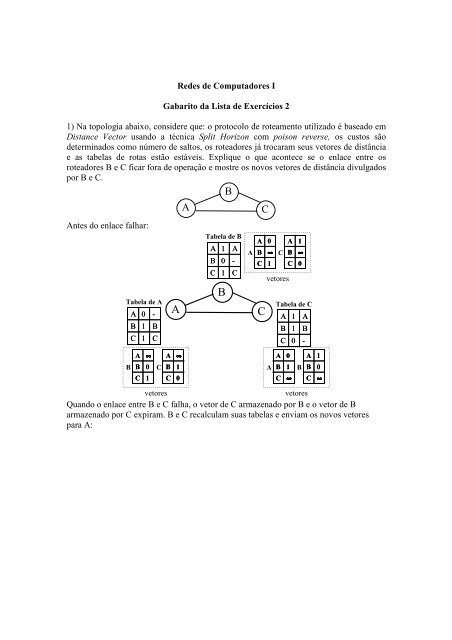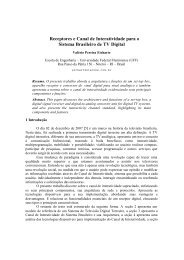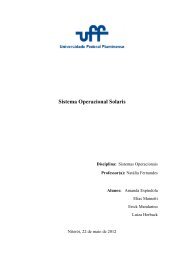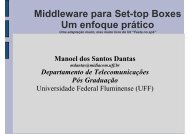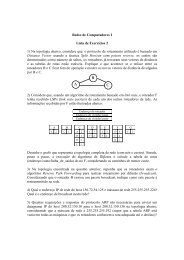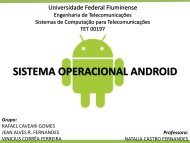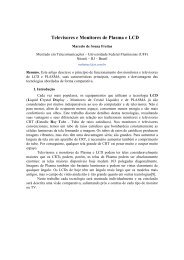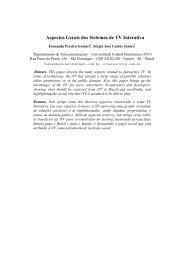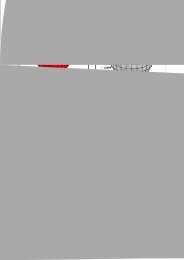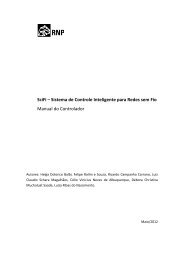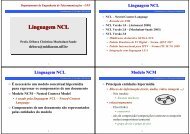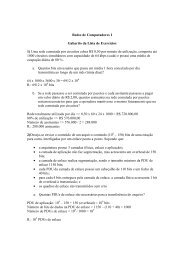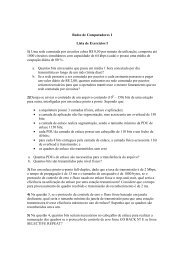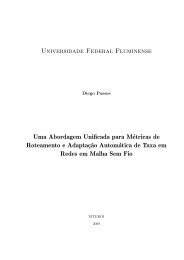Redes de Computadores I Gabarito da Lista de ExercÃcios 2 1 ... - UFF
Redes de Computadores I Gabarito da Lista de ExercÃcios 2 1 ... - UFF
Redes de Computadores I Gabarito da Lista de ExercÃcios 2 1 ... - UFF
You also want an ePaper? Increase the reach of your titles
YUMPU automatically turns print PDFs into web optimized ePapers that Google loves.
<strong>Re<strong>de</strong>s</strong> <strong>de</strong> <strong>Computadores</strong> I<br />
<strong>Gabarito</strong> <strong>da</strong> <strong>Lista</strong> <strong>de</strong> Exercícios 2<br />
1) Na topologia abaixo, consi<strong>de</strong>re que: o protocolo <strong>de</strong> roteamento utilizado é baseado em<br />
Distance Vector usando a técnica Split Horizon com poison reverse, os custos são<br />
<strong>de</strong>terminados como número <strong>de</strong> saltos, os roteadores já trocaram seus vetores <strong>de</strong> distância<br />
e as tabelas <strong>de</strong> rotas estão estáveis. Explique o que acontece se o enlace entre os<br />
roteadores B e C ficar fora <strong>de</strong> operação e mostre os novos vetores <strong>de</strong> distância divulgados<br />
por B e C.<br />
Antes do enlace falhar:<br />
Tabela <strong>de</strong> A<br />
A<br />
0<br />
-<br />
B<br />
1<br />
B<br />
C<br />
1<br />
C<br />
A<br />
A<br />
A<br />
B<br />
C<br />
1<br />
0<br />
1<br />
B<br />
B<br />
Tabela <strong>de</strong> B<br />
A<br />
-<br />
C<br />
A<br />
A<br />
B<br />
C<br />
C<br />
C<br />
0<br />
∞<br />
1<br />
Tabela <strong>de</strong> C<br />
A<br />
B<br />
C<br />
A<br />
C<br />
B<br />
vetores<br />
C<br />
1<br />
1<br />
0<br />
1<br />
∞<br />
0<br />
A<br />
B<br />
-<br />
B<br />
A<br />
B<br />
C<br />
∞<br />
0<br />
1<br />
C<br />
A<br />
B<br />
C<br />
∞<br />
1<br />
0<br />
A<br />
A<br />
B<br />
C<br />
0<br />
1<br />
∞<br />
B<br />
A<br />
B<br />
C<br />
1<br />
0<br />
∞<br />
vetores<br />
vetores<br />
Quando o enlace entre B e C falha, o vetor <strong>de</strong> C armazenado por B e o vetor <strong>de</strong> B<br />
armazenado por C expiram. B e C recalculam suas tabelas e enviam os novos vetores<br />
para A:
Tabela <strong>de</strong> A<br />
A<br />
0<br />
-<br />
B<br />
1<br />
B<br />
C<br />
1<br />
C<br />
A<br />
Tabela <strong>de</strong> B<br />
A<br />
1<br />
A<br />
B<br />
0<br />
-<br />
C<br />
2<br />
A<br />
B<br />
A<br />
A<br />
0<br />
B<br />
∞<br />
C<br />
1<br />
vetores<br />
C<br />
Tabela <strong>de</strong> C<br />
A<br />
1<br />
A<br />
B<br />
2<br />
A<br />
C<br />
0<br />
-<br />
B<br />
A<br />
B<br />
C<br />
∞<br />
0<br />
∞<br />
C<br />
A<br />
B<br />
C<br />
∞<br />
∞<br />
0<br />
A<br />
A<br />
B<br />
C<br />
0<br />
1<br />
∞<br />
vetores<br />
vetores<br />
2) Consi<strong>de</strong>re que, usando um algoritmo <strong>de</strong> roteamento baseado em link state, o roteador F<br />
tenha recebido LSPs (link state packets) <strong>de</strong> ca<strong>da</strong> um dos outros roteadores <strong>da</strong> re<strong>de</strong>. As<br />
informações recebi<strong>da</strong>s por F estão ilustra<strong>da</strong>s abaixo:<br />
En<strong>de</strong>reço do roteador<br />
En<strong>de</strong>reço do vizinho/custo<br />
En<strong>de</strong>reço do vizinho/custo<br />
A<br />
C 2<br />
B<br />
C 1<br />
C<br />
A 2<br />
D<br />
C 3<br />
E<br />
C 2<br />
F<br />
D 4<br />
G<br />
F 1<br />
B<br />
1<br />
F<br />
4<br />
F<br />
4<br />
E<br />
4<br />
D 3<br />
G 1<br />
E 2<br />
Desenhe o grafo que representa a topologia completa <strong>da</strong> re<strong>de</strong> (com nós e custos). Simule,<br />
passo a passo, a execução do algoritmo <strong>de</strong> Dijkstra e calcule a tabela <strong>de</strong> rotas<br />
(en<strong>de</strong>reço/custo/linha_<strong>de</strong>_saí<strong>da</strong>) do nó F, consi<strong>de</strong>rando os caminhos <strong>de</strong> menor custo.<br />
Com as informações recebi<strong>da</strong>s dos outros roteadores contendo os vizinhos <strong>de</strong> ca<strong>da</strong> um e o<br />
custo <strong>de</strong> ca<strong>da</strong> enlace para atingir ca<strong>da</strong> vizinho, po<strong>de</strong>mos montar o mapa <strong>da</strong> topologia <strong>da</strong><br />
re<strong>de</strong>:<br />
A<br />
2 3 D 4<br />
1<br />
C<br />
F G<br />
B<br />
Simulando a execução do algoritmo <strong>de</strong> Dijkstra:<br />
1<br />
2<br />
E<br />
4
1 o . Passo:<br />
nó <strong>de</strong> trabalho: F<br />
vizinhos: D, E, G<br />
tentativas: D(4,F), E(4,F), G(1,F)<br />
permanentes: F (0,-), G(1,F)<br />
2 o . Passo:<br />
nó <strong>de</strong> trabalho: G<br />
vizinhos:<br />
tentativas: D(4,F), E(4,F)<br />
permanentes: F (0,-), G(1,F), D(4,F)<br />
3 o . Passo:<br />
nó <strong>de</strong> trabalho: D<br />
vizinhos: C<br />
tentativas: E(4,F), C(7,D)<br />
permanentes: F (0,-), G(1,F), D(4,F), E(4,F)<br />
4 o . Passo:<br />
nó <strong>de</strong> trabalho: E<br />
vizinhos: C<br />
tentativas: C(6,E)<br />
permanentes: F (0,-), G(1,F), D(4,F), E(4,F), C(6,E)<br />
5 o . Passo:<br />
nó <strong>de</strong> trabalho: C<br />
vizinhos: A, B<br />
tentativas: A(8,C), B(7,C)<br />
permanentes: F (0,-), G(1,F), D(4,F), E(4,F), C(6,E), B(7,C)<br />
6 o . Passo:<br />
nó <strong>de</strong> trabalho: B<br />
vizinhos:<br />
tentativas: A(8,C)<br />
permanentes: F (0,-), G(1,F), D(4,F), E(4,F), C(6,E), B(7,C), A(8,C)<br />
De acordo com os rótulos <strong>de</strong> ca<strong>da</strong> nó no grafo, po<strong>de</strong>mos calcular a tabela <strong>de</strong> rotas <strong>de</strong> F:<br />
Tabela <strong>de</strong> rotas <strong>de</strong> F<br />
En<strong>de</strong>reço Custo Linha <strong>de</strong> Saí<strong>da</strong><br />
A 8 E<br />
B 7 E<br />
C 6 E<br />
D 4 D<br />
E 4 E<br />
F 0 -<br />
G 1 G
3) Na topologia encontra<strong>da</strong> na questão anterior, suponha que os roteadores usam o<br />
algoritmo Reverse Path Forwarding para realizar roteamento por difusão (broadcast).<br />
Consi<strong>de</strong>rando que o roteador B enviou um pacote broadcast, indique como este pacote é<br />
retransmitido na re<strong>de</strong>.<br />
• B transmite para C<br />
• C retransmite para A, D e E<br />
• D retransmite para F<br />
• E retransmite para F<br />
• F recebe duas cópias do pacote, uma retransmiti<strong>da</strong> por D e outra por E. De acordo<br />
com a tabela <strong>de</strong> rotas <strong>de</strong> F, o melhor caminho para atingir B (nó <strong>de</strong> origem)<br />
saindo <strong>de</strong> F é através <strong>de</strong> E, logo a cópia recebi<strong>da</strong> <strong>de</strong> E é retransmiti<strong>da</strong> para G e D,<br />
e a cópia recebi<strong>da</strong> <strong>de</strong> D é <strong>de</strong>scarta<strong>da</strong>.<br />
• D recebe outra cópia do pacote, retransmiti<strong>da</strong> por F. De acordo com a tabela <strong>de</strong><br />
rotas <strong>de</strong> D, o melhor caminho para atingir B (nó <strong>de</strong> origem) saindo <strong>de</strong> D é através<br />
<strong>de</strong> C, logo a cópia recebi<strong>da</strong> <strong>de</strong> F é <strong>de</strong>scarta<strong>da</strong>.<br />
4) Qual o en<strong>de</strong>reço IP <strong>de</strong> re<strong>de</strong> do host 156.72.34.125 e máscara <strong>de</strong> re<strong>de</strong> 255.255.255.224?<br />
Qual é o en<strong>de</strong>reço <strong>de</strong> broadcast nesta re<strong>de</strong>?<br />
156.72.34.125 em binário:<br />
10011100 01001000 00100010 01111101<br />
máscara 255.255.255.224:<br />
11111111 11111111 11111111 11100000<br />
Fazendo um AND do en<strong>de</strong>reço com a máscara (porção do en<strong>de</strong>reço equivalente aos bits<br />
iguais a 1 <strong>da</strong> máscara):<br />
10011100 01001000 00100010 01100000<br />
Resultando no en<strong>de</strong>reço IP <strong>de</strong> re<strong>de</strong>:<br />
156.72.34.96<br />
En<strong>de</strong>reço <strong>de</strong> broadcast nessa re<strong>de</strong>:<br />
10011100 01001000 00100010 01111111<br />
Convertendo para <strong>de</strong>cimal:<br />
156.72.34.127<br />
5) Quantas requisições e respostas do protocolo ARP são necessárias para enviar um<br />
<strong>da</strong>tagrama IP do host 200.32.150.10 para o host 200.32.150.136 na topologia abaixo,<br />
consi<strong>de</strong>rando que a máscara <strong>de</strong> re<strong>de</strong> é 255.255.255.192 (supor que a tabela ARP está<br />
vazia em to<strong>da</strong>s as máquinas e que os roteadores conhecem a rota a<strong>de</strong>qua<strong>da</strong> até o <strong>de</strong>stino)?
Roteador<br />
Roteador<br />
200.32.150.1<br />
200.32.150.65 200.32.150.129<br />
200.32.150.66<br />
200.32.150.10<br />
200.32.150.136<br />
São necessárias 3 requisições e 3 respostas ARP:<br />
• A primeira <strong>da</strong> origem para o primeiro roteador (200.32.150.1)<br />
• A segun<strong>da</strong> do primeiro roteador para o segundo roteador (200.32.150.66)<br />
• A terceira do segundo roteador para o <strong>de</strong>stino (200.32.150.136)<br />
6) Consi<strong>de</strong>re a tabela <strong>de</strong> rotas <strong>de</strong> um roteador IP:<br />
Re<strong>de</strong> IP Máscara Próximo Roteador Interface<br />
139.80.40.64 255.255.255.192 - 139.80.40.65<br />
139.80.40.128 255.255.255.192 - 139.80.40.129<br />
139.80.45.0 255.255.255.0 139.80.40.66 139.80.40.65<br />
139.80.45.64 255.255.255.192 139.80.40.130 139.80.40.129<br />
0.0.0.0 0.0.0.0 200.24.40.2 200.24.40.1<br />
Supondo que este roteador recebeu <strong>da</strong>tagramas para os en<strong>de</strong>reços IP <strong>de</strong> <strong>de</strong>stino<br />
especificados abaixo, quais as interfaces <strong>de</strong> saí<strong>da</strong> e os roteadores usados para alcançar<br />
ca<strong>da</strong> um <strong>de</strong>les?<br />
a) 139.80.40.115<br />
b) 139.80.45.72<br />
c) 139.80.40.10<br />
a) IP <strong>de</strong> <strong>de</strong>stino 139.80.40.115 em binário:<br />
10001011 01010000 00101000 01110011<br />
Fazendo um AND com a máscara 255.255.255.192, resulta em:<br />
10001011 01010000 00101000 01000000<br />
que casa com o en<strong>de</strong>reço IP <strong>de</strong> re<strong>de</strong> 139.80.40.64 <strong>da</strong> primeira linha <strong>da</strong> tabela<br />
Fazendo um AND com a máscara 0.0.0.0, também casa com o prefixo IP 0.0.0.0 (última<br />
linha).<br />
Como a primeira linha é a mais específica, é a escolhi<strong>da</strong>. (interface 139.80.40.65)<br />
b) IP <strong>de</strong> <strong>de</strong>stino 139.80.45.72 em binário:
10001011 01010000 00101101 01001000<br />
Fazendo um AND com a máscara 255.255.255.0, resulta em:<br />
10001011 01010000 00101101 00000000<br />
que casa com o en<strong>de</strong>reço IP <strong>de</strong> re<strong>de</strong> 139.80.45.0 <strong>da</strong> terceira linha <strong>da</strong> tabela<br />
Fazendo um AND com a máscara 255.255.255.192, resulta em:<br />
10001011 01010000 00101101 01000000<br />
que casa com o en<strong>de</strong>reço IP <strong>de</strong> re<strong>de</strong> 139.80.45.64 <strong>da</strong> quarta linha <strong>da</strong> tabela<br />
Fazendo um AND com a máscara 0.0.0.0, também casa com o prefixo IP 0.0.0.0 (última<br />
linha).<br />
Como a quarta linha é a mais específica, é a escolhi<strong>da</strong>. (interface 139.80.40.129, roteador<br />
139.80.40.130)<br />
c) IP <strong>de</strong> <strong>de</strong>stino 139.80.40.10 em binário:<br />
10001011 01010000 00101000 00001010<br />
Fazendo um AND com a máscara 255.255.255.192, resulta em:<br />
10001011 01010000 00101000 00000000 (139.80.40.0)<br />
não casa com o en<strong>de</strong>reço IP <strong>de</strong> re<strong>de</strong> <strong>de</strong> nenhuma linha <strong>da</strong> tabela<br />
Fazendo um AND com a máscara 255.255.255.0, resulta em:<br />
10001011 01010000 00101101 00000000 (139.80.40.0)<br />
que também não casa com o en<strong>de</strong>reço IP <strong>de</strong> re<strong>de</strong> <strong>de</strong> nenhuma linha <strong>da</strong> tabela<br />
Fazendo um AND com a máscara 0.0.0.0, casa com o prefixo IP 0.0.0.0 (última linha).<br />
Logo, a rota <strong>de</strong>fault é a escolhi<strong>da</strong>. (interface 200.24.40.1, roteador 200.24.40.2)<br />
7) <strong>Gabarito</strong> <strong>de</strong>sta questão no site <strong>da</strong> engenharia (www.engenharia.uff.br) => graduação<br />
=> Telecomunicações => Provão => Ano 2002 - questão 18<br />
8) Consi<strong>de</strong>re que uma pequena empresa tem os seguintes equipamentos: 6 estações <strong>de</strong><br />
trabalho (A, B, C, D, E e F), um switch Ethernet <strong>de</strong> 8 portas que implementa VLAN e um<br />
roteador IP com 2 portas Ethernet. O profissional <strong>de</strong> re<strong>de</strong>s <strong>da</strong> empresa <strong>de</strong>seja configurar<br />
duas re<strong>de</strong>s IP distintas (uma com as estações A, B e C e outra com as estações D, E e F)<br />
interliga<strong>da</strong>s pelo roteador. O en<strong>de</strong>reço IP que a empresa possui é 200.32.150.0, máscara<br />
255.255.255.240. Ilustre a topologia <strong>da</strong> re<strong>de</strong> <strong>da</strong> empresa, comente como será feita a<br />
configuração <strong>de</strong> VLANs do switch e indique os en<strong>de</strong>reços IP e máscaras <strong>de</strong> sub-re<strong>de</strong> <strong>de</strong><br />
ca<strong>da</strong> re<strong>de</strong> IP, <strong>de</strong> ca<strong>da</strong> estação <strong>de</strong> trabalho e <strong>da</strong>s interfaces do roteador.<br />
Switch<br />
Ethernet<br />
A B C D E F Roteador
Roteador<br />
1 2<br />
A<br />
B<br />
C<br />
2<br />
3<br />
4<br />
1<br />
5<br />
Switch<br />
Ethernet<br />
8<br />
7<br />
6<br />
D<br />
E<br />
F<br />
VLAN1: portas 1, 2, 3 e 4 do switch Ethernet<br />
VLAN2: portas 5, 6, 7 e 8 do switch Ethernet<br />
VLAN1: sub-re<strong>de</strong> 1: En<strong>de</strong>reço: 200.32.150.0 – máscara: 255.255.255.248<br />
Interface 1 do roteador: 200.32.150.1<br />
Estação A: 200.32.150.2<br />
Estação B: 200.32.150.3<br />
Estação C: 200.32.150.4<br />
VLAN2: sub-re<strong>de</strong> 2: En<strong>de</strong>reço: 200.32.150.8 – máscara: 255.255.255.248<br />
Interface 2 do roteador: 200.32.150.9<br />
Estação D: 200.32.150.10<br />
Estação E: 200.32.150.11<br />
Estação F: 200.32.150.12<br />
9) Suponha dois hosts A e B trocando mensagens através do protocolo <strong>de</strong> transporte TCP.<br />
O host A envia um segmento TCP para B com as seguintes informações no cabeçalho e<br />
com 600 bytes <strong>de</strong> <strong>da</strong>dos:<br />
− Sequence number: 1001; Acknowledgement number: 2020; Window: 3000<br />
Sabendo que o buffer <strong>de</strong> recepção <strong>de</strong> B tinha 4000 bytes <strong>de</strong> espaço livre antes <strong>de</strong> receber<br />
o segmento acima, quais as informações dos mesmos campos no próximo segmento TCP<br />
enviado <strong>de</strong> B para A carregando 800 bytes <strong>de</strong> <strong>da</strong>dos, após receber corretamente o<br />
segmento acima?<br />
Segmento enviado <strong>de</strong> B para A:<br />
- sequence number: 2020<br />
- acknowledgement number: 1601<br />
- window: 3400


